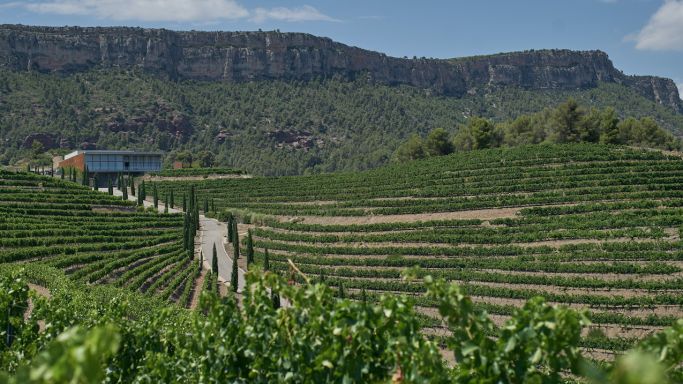Last week's wine of the week was – hangs head in shame – available from only one retailer in only one country. This week's is apparently ubiquitous.
From €20.99, 8,200 Hungarian forints, 259 Swedish kronor, CA$37, £21.50, $34.99, 118.70 Polish zloty, 28.50 Swiss francs, 688 Czech koruna, 294.90 Norwegian kroner, 3,550 Japanese yen, NZ$54.99, 5,189 Icelandic kronur, 3,330 roubles, HK$341, AU$62.60, 329 Brazilian reais
I vividly remember visiting Priorat for the first time while whizzing round northern Spain with fellow wine writer Victor de la Serna in 2000. Substantial tracts of the steep, rugged slopes of this sleepy wine region were being landscaped and planted by the large Barcelona-based wine company now known as Familia Torres (to distinguish the original Spanish company from their Chilean operation Miguel Torres and Marimar Estate run by Marimar Torres in California – not to mention their distribution company in China).
As Purple Pagers can see in our tasting notes database, we have tasting notes on vintages of Torres’ Priorat flagship Salmos from 2006 but I was particularly impressed recently by the 2016, the current vintage that is widely distributed worldwide.
Total rainfall in 2016 was close to the average of just over 500 mm (20 in) but the growing season was pretty dry. The year started cool, summer was normal but September and October were particularly warm, which seems to have suited the Carinyena (Carignan) variety, which can be uncomfortably high in acidity in cooler vintages. The blend in this particular vintage is 50% Garnacha (Grenache), 45% Carinyena and 5% Syrah. Torres are deliberately decreasing the Syrah component, as many other Priorat producers are doing or have done.
The vines for Salmos were planted between 1998 and 1999 on the fast-draining dark slate (llicorella) slopes that characterise this distinctive wine region. (I would nominate Priorat and the Wachau Achleiten vineyard as two of the places that most obviously impose a terroir imprint on their wines.) Torres have major holdings in El Lloar (25 ha/62 acres at 250 m/820 ft elevation), where Carinyena thrives, and in Porrera (50 ha/124 acres at 500 m/1,640 ft), whose elevation can bring freshness to the Garnacha. About 95% of the grapes for Salmos come from their own vineyards.
Salmos 2016 certainly isn’t as dramatic as some of the cult Priorats, but then it isn’t nearly as expensive, and I think it would provide a great introduction to the characterful, grainy reds of this region. I really enjoyed the tannins and bright liquorice-flavoured fruit – and, like many a typical Priorat, drinking it almost gave me the impression of licking warm, textured stones, though it certainly isn’t short of fruit. I’d suggest decanting it to get the most out of it aromatically and there is absolutely no hurry to drink this wine. I gave it a score of 16.5+ and reckon it should drink well until 2028.
Technical details are that the wine was fermented in tank over nine to 12 days and kept on the skins for a total of 20 days. It then spent 14 months in French oak, 25% new, and was bottled in July 2018.
The very first vintage of Salmos was 2005 and the first few vintages were made in a rented garage before a winery was built overlooking the Lloar vineyard (see main picture) in 2008, although the company apparently bottled small quantities of Priorat in the 1920s. They still have a few bottles of Tres Torres 1928 Priorat Superior and a Coronas 1923 Priorat Superior – bottled in 1932.
Salmos means ‘psalms’ and was chosen as a nod to the Carthusian order which established a priory (priorat) in the region in the eleventh century.
Miguel Torres Maczassek, seen above in Porrera, reckons the 2016 is the best Salmos of last decade and it has been the most awarded. It won a trophy – first position in the Priorat category – in the International Wine Challenge and was also the top Priorat in the important Catalan wine competition Premis Vinari.
He told me:
‘Our project continues in the Priorat. I started some years ago acquiring small plots of land considered "no man's land" at about 750 m [2,460 ft] above sea level; and we are planting them. It is actually the highest vineyard in Priorat with llicorella and it’s therefore really a long-term project designed to cope with climate change. In 2018 we planted 0.3 hectare [0.7 acre] with Cariñena, Garnacha, Garró, and Picapoll with bush-trained vines in order to study how they adapt at this altitude. At the beginning of 2020 we planted a full hectare. No wine to taste yet!
‘Mas de la Rosa continues to be our most special old-vine vineyard in Porrera producing 200 cases from 1.9 ha [4.7 acres]. Perpetual is our second in the pyramid, made only with 70+ year-old vines of Garnacha and Cariñena from five villages.’
(Miguel’s father, Miguel A Torres, was one of the first wine producers of any size to recognise the threats of climate change. It’s worth noting that, with Jackson Family Wines, Familia Torres has formed International Wineries for Climate Action (IWCA), urging others to join them in taking proactive steps to combat climate change by cutting down on carbon emissions. The number of members is growing.)
Mas de la Rosa sells for upwards of £200 a bottle and I was pretty impressed by the first vintage, 2016. Perpetual is a mere £33 a bottle and Ferran was impressed by the 2015 but I was rather disappointed by the 2017 I tasted recently.
The Salmos 2016 is stocked quite widely in the UK and stockists not mentioned via the 'Find this wine' Wine-Searcher link above and below include Hoults Wine Merchants, Paul Adams Fine Wines, Constantine Stores, Latitude and Grape & Grain.
It is also available in Spain (not surprisingly), throughout the EU and Scandinavia, Switzerland, Iceland, Japan, Australia, New Zealand, Hong Kong, Russia, Brazil and widely in the US.



